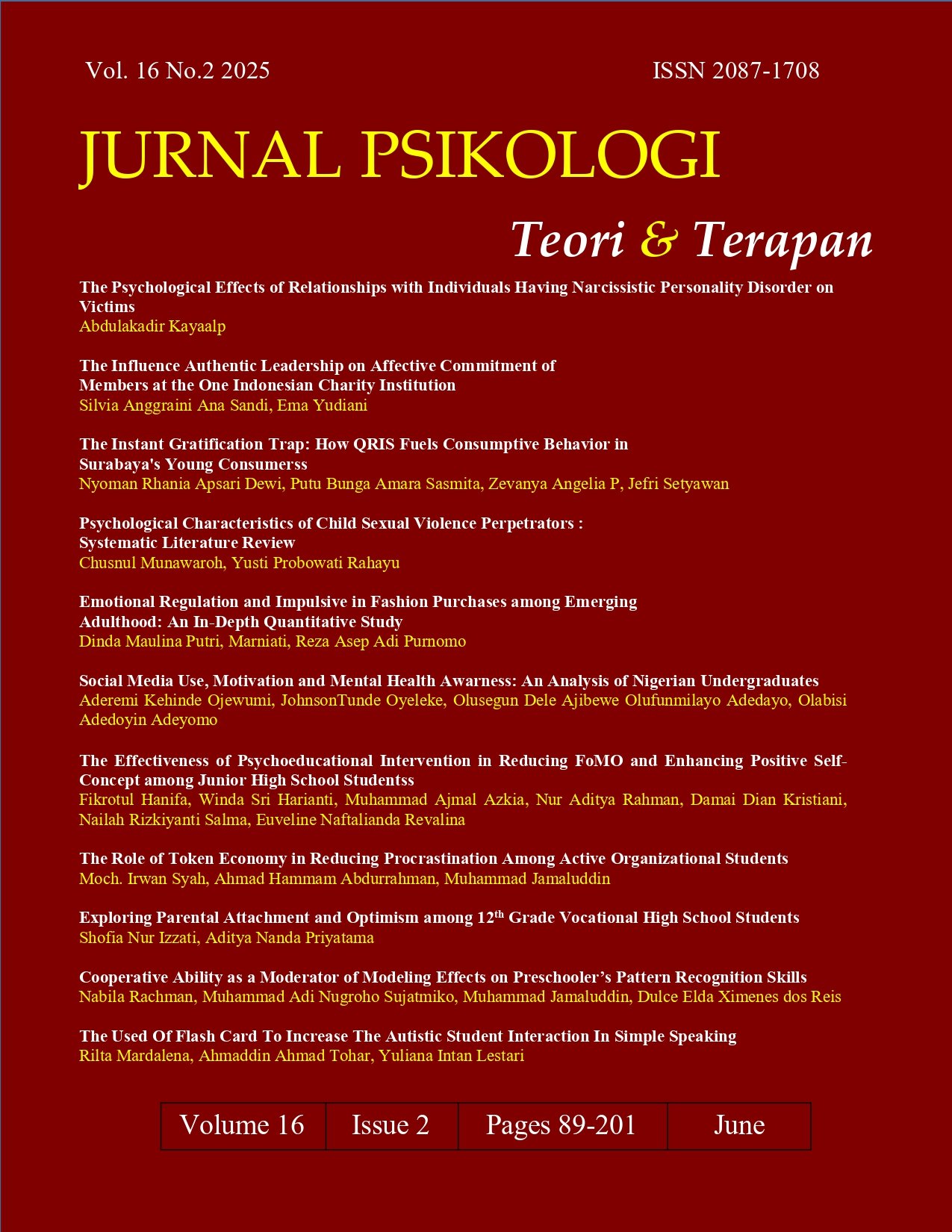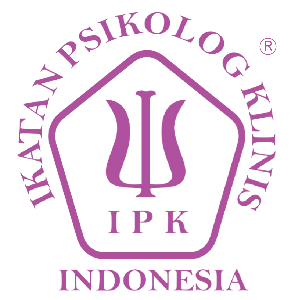Exploring Parental Attachment and Optimism among 12th Grade Vocational High School Students
DOI:
https://doi.org/10.26740/jptt.v16n02.p172-179Keywords:
Optimism, parental attachment, vocational high schoolAbstract
Background: Statistics Indonesia has recorded that vocational high school graduates have had the highest Open Unemployment Rate (OUR) since 2022. This situation poses a challenge for final-year students, making it important to maintain optimism. Parental attachment can serve as a factor in shaping individual optimism. Objective: Understanding the relationship between Parental Attachment and optimism in final-year vocational high school students. Method: Quantitative research with a correlational design using Pearson Product Moment analysis. Respondents were 290 twelfth-grade students from a school in Surakarta, selected using cluster random sampling. The instruments used were the Life Oriented Test-Revised (r = 0.715) and the Parental Attachment Scale (r = 0.948). Results: There is a relationship between parental attachment and optimism in students (r=0.231; p<0.05), although the relationship is considered low. The study found differences in parental attachment scores between male and female students (Mdifference=11.341, p<0.05). Conclusion: The higher the parental attachment, the higher the students’ optimism. Future research can enrich the sample size, examine gender disparities, and explore internal factors related to optimism.
Abstrak
Latar Belakang: Badan Pusat Statistik mencatat lulusan SMK berada pada posisi tertinggi Tingkat Pengangguran Terbuka (TPT) sejak 2022. Kondisi ini menjadi tantangan bagi siswa tingkat akhir yang sedang menjalani masa transisi kehidupan, sehingga penting untuk memiliki optimisme. Kelekatan orang tua mampu menjadi faktor pembentuk optimisme individu. Tujuan: Mengetahui hubungan antara kelekatan orang tua dengan optimisme pada siswa tingkat akhir SMK. Metode: Penelitian kuantitatif dengan desain korelasional menggunakan teknik analisis Pearson Product Moment. Subjek adalah 290 siswa kelas 12 (NLaki-laki=272; NPerempuan=18) salah satu SMK di Surakarta dengan metode cluster random sampling. Optimisme diukur dengan Skala Life Oriented Test-Revised (r = 0.715) dan kelekatan orang tua diukur dengan Skala Kelekatan Orang Tua (r = 0.948). Hasil: Terdapat hubungan signifikan antara kelekatan orang tua dengan optimisme pada siswa (r=0.231; p<0.05) namun hubungan tergolong rendah. Hasil penelitian juga menemukan perbedaan nilai kelekatan orang tua siswa laki-laki dan perempuan (Mdifference=11.341, p<0.05) Simpulan: Hasilnya semakin tinggi kelekatan orang tua, semakin tinggi optimisme siswa. Penelitian selanjutnya dapat memperkaya jumlah sampel, melihat ketimpangan jenis kelamin, serta mengeksplorasi faktor internal yang berhubungan dengan optimisme.
References
Armsden, G., & Greenberg, M. (1987). The inventory of parent and peer attachment: Individual differences and their relationship to psychological well-being in adolescence. Journal of Youth and Adolescence, 16, 427–454. https://doi.org/10.1007/BF02202939
Badan Pusat Statistik Indonesia. (2025). Tingkat pengangguran terbuka berdasarkan tingkat pendidikan, https://www.bps.go.id/id/statistics-table/2/MTE3OSMy/tingkat-pengangguran-terbuka-berdasarkan-tingkat-pendidikan.html.
Bowlby, J. (1969). Attachment and loss. Volume I, Attachment. Basic Books.
Burešová, I., Jelínek, M., Dosedlová, J., & Klimusová, H. (2020). Predictors of mental health in adolescence: The role of personality, dispositional optimism, and social support. SAGE Open, 10(2). https://doi.org/10.1177/2158244020917963
Carver, C. S., & Scheier, M. F. (2017). Optimism, coping, and well‐being. In The Handbook of Stress and Health (pp. 400–414). Wiley. https://doi.org/10.1002/9781118993811.ch24
Carver, C. S., & Scheier, M. F. (2023). Optimism. In Encyclopedia of Quality of Life and Well-Being Research (pp. 4849–4854). Springer International Publishing. https://doi.org/10.1007/978-3-031-17299-1_2018
Delgado, E., Serna, C., Martínez, I., & Cruise, E. (2022). Parental attachment and peer relationships in adolescence: A systematic review. International Journal of Environmental Research and Public Health, 19(3), 1–22. https://doi.org/10.3390/ijerph19031064
Direktorat Jenderal Pendidikan Vokasi. (2022). Rencana strategis direktorat jenderal pendidikan vokasi tahun 2020-2024. https://vokasi.kemendikdasmen.go.id/Informasi-Publik/Renstra
Faria, K. D. (2020). The impact of attachment and optimism on delinquency [The University of Nevada, Las Vegas]. https://doi.org/http://dx.doi.org/10.34917/36114702
Hadi, S. (2020). Statistik (Edisi revisi). Pustaka Pelajar.
Hadi, Y., & Alfiasari. (2023). Parental and peer attachment as determinant factors of adolescent’s optimism. Journal of Child, Family, and Consumer Studies, 2(2), 90–100. https://doi.org/10.29244/jcfcs.2.2.90-100
Heinonen, K., Räikkönen, K., Keltikangas-Järvinen, L., & Strandberg, T. (2004). Adult attachment dimensions and recollections of childhood family context: Associations with dispositional optimism and pessimism. European Journal of Personality, 18(3), 193–207. https://doi.org/10.1002/per.508
Idriyani, N. (2020). Adaptasi alat ukur kelekatan dengan orang tua. UIN Syarif Hidayatullah Jakarta. https://repository.uinjkt.ac.id/dspace/handle/123456789/59974
Izzaty, R. E., & Ayriza, Y. (2021). Parental bonding as a predictor of hope in adolescents. Psikohumaniora, 6(1), 77–90. https://doi.org/10.21580/pjpp.v6i1.7981
Kealy, D., Ben-David, S., & Cox, D. W. (2022). Early parental support and meaning in life among young adults: The mediating roles of optimism and identity. Current Psychology, 41(6), 3865–3872. https://doi.org/10.1007/s12144-020-00907-w
Liu, Q., & Wang, Z. (2021). Associations between parental emotional warmth, parental attachment, peer attachment, and adolescents’ character strengths. Children and Youth Services Review, 120. https://doi.org/10.1016/j.childyouth.2020.105765
Miljkovitch, R., Mallet, P., Moss, E., Sirparanta, A., Pascuzzo, K., & Zdebik, M. A. (2021). Adolescents’ attachment to parents and peers: Links to young adulthood friendship quality. Journal of Child and Family Studies, 30(6), 1441–1452. https://doi.org/10.1007/s10826-021-01962-y
Periantalo, J. (2023). Validitas alat ukur psikologi: aplikasi praktis. Pustaka Pelajar.
Ranson, K. E., & Urichuk, L. J. (2008). The effect of parent-child attachment relationships on child biopsychosocial outcomes: A review. Early Child Development and Care, 178(2), 129–152. https://doi.org/10.1080/03004430600685282
Renaud, J., Barker, E. T., Hendricks, C., Putnick, D. L., & Bornstein, M. H. (2019). The developmental origins and future implications of dispositional optimism in the transition to adulthood. International Journal of Behavioral Development, 43(3), 221–230. https://doi.org/10.1177/0165025418820629
Republik Indonesia. (2003). Undang-Undang Republik Indonesia Nomor 20 Tahun 2003 tentang Sistem Pendidikan Nasional (Lembaran Negara Republik Indonesia Tahun 2003 Nomor 78 Tambahan Lembaran Negara Nomor 4301).
Scheier, M. F., Carver, C. S., & Bridges, M. W. (1994). Distinguishing optimism from neuroticism (and trait anxiety, self-mastery, and self-esteem): A reevaluation of the life orientation test. Journal of Personality and Social Psychology, 67(6), 1063–1078. https://doi.org/10.1037//0022-3514.67.6.1063
Sholihah, S. M., Aditya, N. Y., Evani, E. S., & Maghfiroh, S. (2023). Konsep uji asumsi klasik pada regresi linier berganda. Jurnal Riset Akuntansi Soedirman, 2(2), 102–110.
Sugiyono. (2018). Metode penelitian kuantitatif. Alfabeta.
Sugiyono. (2019a). Metode penelitian kuantitatif, kualitatif, dan r&d. Alfabeta.
Sugiyono. (2019b). Statistika untuk penelitian. Alfabeta.
Supervía, P. U., Bordás, C. S., & Lorente, V. M. (2020). Exploring the psychological effects of optimism on life satisfaction in students: The mediating role of goal orientations. International Journal of Environmental Research and Public Health, 17(21), 1–9. https://doi.org/10.3390/ijerph17217887
Suryadi, B., Hayat, B., & Putra, M. D. K. (2021). The Indonesian version of the life orientation test-revised (LOT-R): Psychometric properties based on the Rasch model. Cogent Psychology, 8(1), 1–19. https://doi.org/10.1080/23311908.2020.1869375
Taylor, Z. E., Kittrell, N., Nair, N., Evich, C. D., & Jones, B. L. (2020). Developmental antecedents of adolescent optimism in rural Midwestern U.S. Latinx youth. Journal of Community Psychology, 48(2), 448–463. https://doi.org/10.1002/jcop.22267
Thomson, K. C., Schonert-Reichl, K. A., & Oberle, E. (2015). Optimism in early adolescence: Relations to individual characteristics and ecological assets in families, schools, and neighborhoods. Journal of Happiness Studies, 16(4), 889–913. https://doi.org/10.1007/s10902-014-9539-y
Uddin, M. K., Nahar, N., & Parvin, M. (2024). Parental love and well-being of young adults: The mediating role of optimism. Trends in Psychology, 32(1), 61–83. https://doi.org/10.1007/s43076-022-00185-4
Uribe, F. A. R., Espejo, C. A. N., & Pedroso, J. da S. (2022). The role of optimism in adolescent mental health: A systematic review. Journal of Happiness Studies, 23(2), 815–845. https://doi.org/10.1007/s10902-021-00425-x
Widana, W., & Muliani, P. L. (2020). Uji persyaratan analisis. Klik Media.
Wulansari, A. D. (2018). Aplikasi statistika parametrik dalam penelitian (R. Widyaningrum, Ed.). Pustaka Felicha.
Downloads
Published
How to Cite
Issue
Section
License
Copyright (c) 2025 Shofia Nur Izzati, Aditya Nanda Priyatama

This work is licensed under a Creative Commons Attribution 4.0 International License.
Authors who publish in this journal agree to the following terms:
Copyright in any article is held by the author.
The author grants the journal, publication rights with the work simultaneously licensed under a Creative Commons Attribution License that allows others to share the work with an acknowledgment of the work's authorship and initial publication in this journal.
Authors may enter into separate, additional contractual arrangements for the non-exclusive distribution of the journal's published version of the work (e.g., posting it to an institutional repository or publishing it in a book), with an acknowledgment of its initial publication in this journal.
Authors are permitted and encouraged to post their work online (e.g., in an institutional repository or on their website) prior to and during the submission process, as this can lead to productive exchanges, as well as earlier and greater citation of published work.
 Abstract views: 297
,
Abstract views: 297
, PDF Downloads: 183
PDF Downloads: 183


















